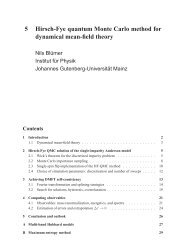Hubbard Model for Asymmetric Ultracold Fermionic ... - KOMET 337
Hubbard Model for Asymmetric Ultracold Fermionic ... - KOMET 337
Hubbard Model for Asymmetric Ultracold Fermionic ... - KOMET 337
Create successful ePaper yourself
Turn your PDF publications into a flip-book with our unique Google optimized e-Paper software.
= ∑ ijlσ= − ∑ ijlσ= ∑ ijlσ= ∑ ijlσ= − ∑ ijlσ= − ∑ ijlσ5.2. GENERAL PROCEDURE 51(resetting the bookkeeping parameter λ to 1) we get a <strong>Hubbard</strong> model with“reduced”hopping.In second order in λ we may choose S 2 (d). Equations (5.14) and (5.20) are fullfilled by:The second order correction to the Hamiltonian is given by:S 2 (d) = 1U 2[H + + H − ,H 0 ] . (5.30)H t,2 = 1 U [H +,H − ] . (5.31)We are now able to calculate (5.31) in terms of d † and d in order to analyze the structure ofsecond order perturbation theory at strong coupling.5.2.3 Structure of the second order termNow we focus attention on <strong>Hubbard</strong> models of the type (5.6) with the constraint:t iiσ = 0 ; ∀i,σ . (5.32)That means, that each site has the same local energy, which is chosen equal to zero. We thenobtain an expression <strong>for</strong> H t,2 in terms of d and d † . There<strong>for</strong>e it is necessary to calculate thecommutation relations appearing in (5.31):The second order contribution can be written as:[d † iσ d jσ ,d† kη d lη ] , (5.33)[d † iσ d jσ , ¯n l−η (1 − ¯n k−η)] . (5.34)H t,2 = 1 U6∑H t2,i (5.35)i=1with the components:H t2,1t ijσt liσ(1 − ¯n i−σ)¯n j−σ¯n l−σd † lσ d jσ(5.36)H t2,2t ijσt jlσ(1 − ¯n i−σ)¯n j−σ(1 − ¯n l−σ)d † iσ d lσ(5.37)H t2,3t ijσt il−σ(1 − ¯n j−σ)¯n lσd † iσ d jσ d† i−σ d l−σ(5.38)H t2,4t ijσt lj−σ¯n i−σd † iσ d jσ (1 − ¯n lσ )d† l−σ d jσ(5.39)H t2,5t ij−σt jlσ¯n l−σ¯n iσd † jσ d lσ d† i−σ d j−σ(5.40)H t2,6t ij−σt liσ(1 − ¯n l−σ)d † lσ d iσ (1 − ¯n jσ )d† i−σ d j−σ. (5.41)At this point we recognize that the second order contributions can be described as pairwisehopping of fermions. The terms H t2,1 and H t2,2 describe double hopping of one fermionto a different or to the same site and the other terms describe pairwise hopping of twofermions with different pseudospin indices. None of the terms changes the number of doubleoccupancies in the d-language.













